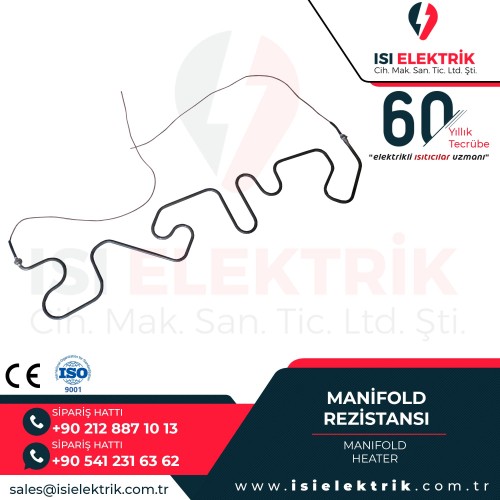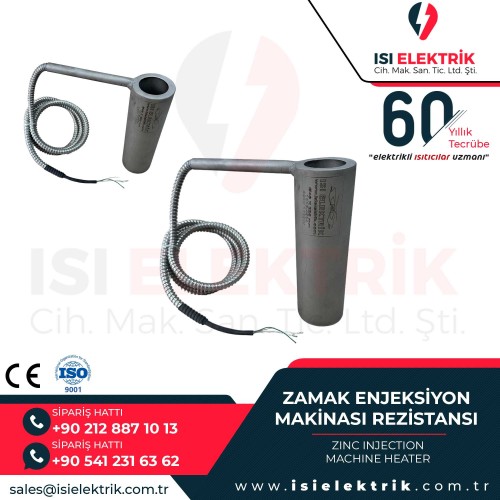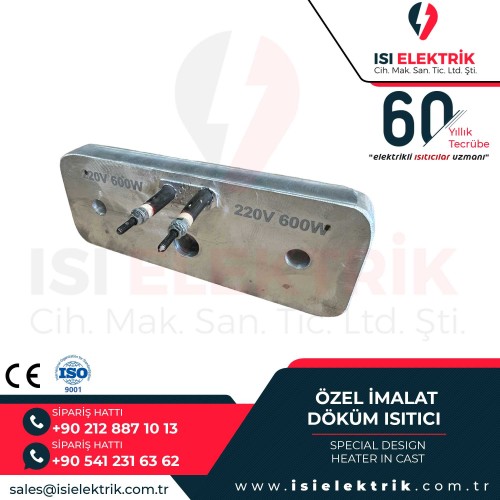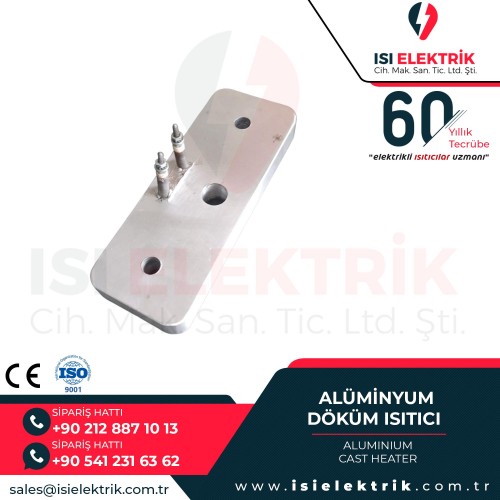Manifold Heaters
Manifold heaters contribute to the heating of the manifolds. These are
the hot-track heater types of products. These products are used in mold and
press machines to improve heating performance. At the same time, because they
are high-tech products, they have a wide range of functions. These products
distinguish themselves as heater types that can operate at extremely high
temperatures.
Manifold heaters are typically made in square and cylindrical shapes. Contact with the surface is maximized in square models. As a result, the manifold can reach the required temperature in much less time. When you use the right product, you can reach the intended temperature in a short period. This not only saves energy but also ensures long-term resistance.
These are the first tubular type heaters that can be bent manually in various manifold types that are used all over the world. You can get information about productions which are special to your needs by contacting us right now.
Applications of Manifold Heaters
Manifold heaters have a wide range of applications and are specially designed heating elements used for heating manifold systems. These heaters are manufactured in different cross-sections and shapes depending on their intended use and application. Custom-designed manifold heaters offer high performance and efficiency, making them ideal for various industries. They are most commonly used in plastic injection molding and rubber molding processes.
Plastic Injection and Rubber Molding: In plastic injection and rubber molding processes, maintaining an optimal mold temperature is crucial. Manifold heaters help stabilize the temperature during injection, improving product quality and enhancing production efficiency.
Packaging Industry: The packaging industry requires stable and efficient heating solutions for machines and equipment. Manifold heaters provide effective heating in these applications, ensuring fast and reliable packaging processes.
Plastic Welding and Mold Heating: In plastic welding applications, achieving and maintaining specific temperature levels is essential. Manifold heaters are used in plastic welding machines and mold heating systems to ensure stable temperature control.
Metal Processing and Automotive Industry: Manifold heaters are widely used in metal processing machines and the automotive industry. They are preferred in specialized production lines and precision machining operations where precise temperature control is required.
Food Processing: In food processing and production facilities, specific temperature levels must be maintained throughout various processes. Manifold heaters provide a reliable heating solution in these applications, ensuring hygienic and efficient production processes.
The flexible design options of manifold heaters make them suitable for various industries. Available in different power and voltage configurations, these heaters offer a reliable and long-lasting heating solution for industrial production processes.
Manifold Heaters Technical Specification
• Manifold heaters can be produced as square sections. Standard
dimensions in square sections are 6x6 and 8x8 mm.
• Depending on your requirements, these products can
also be manufactured with a circular cross-section. The dimensions of the
circular section are 6.5 and 8.5.
• Products have metal braided covers for high
protection.
• Manifold heaters can show high performance up to 350
degrees.
• Working voltage of these heaters is 230 V as standard.
• They are also flexible heaters that can be bent very
easily.
• Minimum bending diameter is 15 mm in manifold heaters.
It can be between 25 mm and 35 mm in cold regions.
• Its length ranges from 330 to 1550 mm. In addition, we
can produce in any size you require.
• Better heat transfer in mainline heating tasks. At the same time, you can reduce tool mass while consuming less energy.
• Surface contact is reduced when round heaters are
used. It should be noted that in this case, reaching the right temperature will
take longer.
• We manufacture manifold heaters with different winding
types and different traction directions.
• These products have high durability. In this way, they can work with high performance for many years.
Manifold Heater Prices
Manifold heaters are manufactured in various power levels, sizes, and designs to meet different application needs. Prices vary depending on the specifications, power requirements, and materials used. To get a price quote for the most suitable manifold heater for your application, feel free to contact us. Our technical team will assist you in choosing the most efficient and durable heater for your requirements.
When selecting a manifold heater, it is essential to consider factors such as operating temperature, energy consumption, size, and mounting method. Choosing a high-performance heater will optimize your production processes and help you achieve significant energy savings in the long run.
For custom designs and specialized projects, our manifold heaters come with various material and coating options. Whether you need stainless steel, brass, or nickel alloy heaters, we provide durable solutions resistant to wear and high temperatures, ensuring long-lasting performance.
Our company is committed to offering the best price-performance ratio for manifold heater solutions. Contact us today to get detailed pricing information and select the best product for your application. Reach out to us now for a price quote and enhance your production efficiency with our high-quality manifold heaters!
Manifold Heaters
Manifold heater is a heating element used in injection molds and other industrial applications. It ensures the homogeneous heating and flowing of molten plastics in hot runner systems.
Types of Manifold Heaters
- Flexible Manifold Heaters: These are flexible heaters that can be wrapped around pipes or surfaces to shape. They can adapt to complex surfaces and provide a flexible heating solution.
- Stainless Steel Manifold Heaters: Widely used in industries with hygienic requirements, stainless steel manifold heaters are preferred for their durability and corrosion resistance.
- Immersion Manifold Heaters: Designed for direct heating within liquids, these heaters are placed inside tanks or containers to ensure homogeneous heating of the liquid.
- High-Density Manifold Heaters: These heaters provide intense energy to a specific area. They are preferred for specialized industrial applications requiring intense heating.
- Flexible Temperature Control Manifold Heaters: Used in applications requiring precise temperature control, these heaters can quickly respond to temperature changes when used with sensitive thermal sensors.
Technical Specifications of Manifold Heaters
- Power Output: Variable, ranging from 100 Watts to 5000 Watts.
- Electric Voltage: Can operate within voltage ranges of 12 Volts to 480 Volts.
- Maximum Temperature Capacity: Can provide heating from 100°C to 800°C.
- Cross-Sectional Shape: Available in square, cylindrical, or other various cross-sectional shapes.
- Manufacturing Material: Can be made of nickel-chromium, stainless steel, Inconel, and other durable materials.
- Connection Type: Available in nutted, pistoned, or other various connection types.
- Thermocouple Type: Compatible with J, K, T, E, and other thermocouple types.
- Heating Element Type: Various heating element types are available, such as wire-wound, mica-band, or ceramic-insulated.
- Cooling Method: Can be designed for air-cooling or water-cooling.
- Protection Class: Can have a protection class of IP65 or higher.
- Mounting Type: Compatible with flanged, threaded, or different mounting types.
Applications of Manifold Heaters
- Greenhouse and Agricultural Applications: Used to control temperature and provide heating for plant cultivation in greenhouses and agricultural settings.
- Water and Wastewater Treatment Plants: Utilized for heating water, controlling chemical reactions, and treatment processes in water and wastewater treatment plants.
- Packaging Industry: Used for shaping packaging materials, ensuring seal integrity, and heating processes in packaging applications.
- Marine and Ships: Used for heating ship tanks, protecting marine vessels from freezing, and other maritime applications.
- Swimming Pools and Spa Facilities: Utilized for heating swimming pools and controlling water temperature in spa facilities.
- Building and Residential Heating Systems: Used in heating systems for buildings and homes, including heating radiators and hot water tanks.
- Tire Industry: Used in tire manufacturing processes, including molding and vulcanization.
Advantages of Manifold Heaters
- Energy Efficiency: Manifold heaters allow direct transfer of energy by coming into contact with the heating surface, minimizing energy loss and increasing energy efficiency in the system.
- Controllability: Integrated with precise control systems, manifold heaters enable easy control of parameters such as temperature and power output, providing more control and flexibility to the operation.
- Environmental Friendliness: Compared to gas or steam usage, manifold heaters offer a more environmentally friendly heating solution, producing fewer emissions and waste, thereby reducing environmental impact.
- Cost-effectiveness: Manifold heaters are generally more cost-effective compared to other heating methods, offering advantages in both installation and operational costs.
- Space Saving: Manifold heaters occupy less space and have a more compact design compared to other heating systems, allowing for more efficient use of space within the facility.
- Safety: Manifold heaters can be equipped with various safety measures. Features like overheat protection and overcurrent protection enhance safety in the system.
- Flexible Adaptation: Manifold heaters can be manufactured in different sizes, shapes, and power levels, allowing easy adaptation to various application requirements.
Materials Used in Manifold Heater Manufacturing
Manifold heaters are manufactured using special materials that can withstand high-temperature conditions and ensure long-lasting performance. These materials are carefully selected to optimize heat transfer, enhance corrosion resistance, and extend the lifespan of the heater. Below are some of the most commonly used materials in manifold heater manufacturing and their characteristics.
- Stainless Steel (304, 316, 321): The most commonly used material for manifold heater bodies. It provides excellent high-temperature resistance, mechanical strength, and corrosion resistance, ensuring long-lasting performance. Specifically, 316 stainless steel offers superior protection against aggressive chemicals.
- Titanium: Titanium is known for its lightweight yet highly durable structure, making it ideal for applications requiring high-temperature and corrosion resistance. It is often used in chemically aggressive environments and specialized manifold heater designs.
- Inconel Alloys: These alloys provide superior mechanical properties compared to stainless steel, making them suitable for high-temperature applications. Inconel retains its structural integrity even under extreme heat conditions, ensuring long-term durability.
- Fiberglass and Ceramic Insulation Materials: High-temperature-resistant insulation materials such as fiberglass and ceramic are used to insulate heaters. These materials help retain heat, improve energy efficiency, and create a safer working environment.
- Magnesium Oxide (MgO): Used as an insulating material for heater wires, MgO provides excellent thermal conductivity and ensures efficient performance while offering electrical insulation for safe operation.
- Coating Materials: Some manifold heaters feature protective coatings such as nickel, chromium, or ceramic-based coatings to enhance their resistance in harsh environments. These coatings help improve durability and protect against external factors.
- High-Temperature Resistant Plastics: In some industrial applications, heat-resistant plastic materials are used, particularly in insulation and mounting components. These plastics maintain their shape under high temperatures and provide excellent electrical insulation.
- Gold and Platinum Coatings: In sensitive electronics and laboratory applications, heater wires may be coated with gold or platinum. These coatings improve electrical conductivity and corrosion resistance, ensuring a longer lifespan.
- Copper and Brass Terminals: Copper and brass terminals, known for their high electrical conductivity, minimize energy loss and enhance efficiency. When combined with stainless steel, they provide increased durability.
- Aluminum and Zinc Alloys: These lightweight yet durable materials are used in specific manifold heater components, especially to optimize heat distribution and efficiency.
The materials used in manifold heaters vary depending on the application area and environmental conditions. Selecting the right material is crucial, as it directly affects the efficiency and durability of the system. A manifold heater made from high-quality materials provides a long-lasting and high-performance heating solution.
Manifold Heater Selection: Which Technical Details Should Be Considered?
- Application Duration and Frequency: Durable and long-lasting heaters are preferred for more intensive or continuous usage.
- Regional Heating Requirement: If there is an intense heating requirement in a specific area, an appropriate model should be selected.
- Cost and Budget: It should be compatible with the operating budget. Long-term cost-benefit analysis should be conducted.
- Integration and Compatibility: It should be compatible with other equipment and function smoothly within the system.
- Maintenance and Repair Ease: Maintenance and repair should be easy. Spare parts should be readily available.
- User Experience and Feedback: User experiences and feedback provide valuable insights. User reviews and references should also be considered.
Features of Manifold Heaters That Ensure High Thermal Efficiency
Manifold heaters are widely preferred in various industries due to their specially designed structures that provide high thermal efficiency. These heaters utilize energy with minimal loss and maximum efficiency, enhancing performance while reducing operational costs. Here are some key features of manifold heaters that ensure high thermal efficiency:
- Precise Temperature Control: Manifold heaters maintain a stable temperature within a specific range, preventing overheating or uneven heat distribution. This minimizes energy wastage.
- Homogeneous Heat Distribution: Manufactured with advanced design techniques, manifold heaters evenly distribute heat across the surface, ensuring optimal operating conditions. This allows maximum efficiency without unnecessary energy consumption.
- High Thermal Conductivity: Made from high-quality alloys, these heaters enhance heat transmission performance, providing faster and more effective heating. As a result, higher temperatures can be reached with lower energy consumption.
- Energy-Efficient Materials: The high-quality insulation materials and coatings used in manifold heaters minimize heat loss and improve energy efficiency.
- Rapid Heating and Cooling Time: Due to materials that quickly transfer heat, manifold heaters reach the desired temperature in a short time, preventing unnecessary energy consumption.
- Custom Design Options: Manifold heaters can be specially designed according to their application, integrating efficiently into specific systems and preventing unnecessary energy consumption for enhanced performance.
- Durable and Long-Lasting Structure: Thanks to high-quality materials and specialized production techniques, manifold heaters provide long-term use, reducing maintenance and replacement costs.
With their advanced design features and high-quality materials, manifold heaters maximize energy efficiency. When chosen correctly, they provide energy savings while improving system performance.
Saving Energy with Manifold Heaters
Manifold heaters are specially designed heating elements used in industrial heating systems to optimize energy consumption and reduce operational costs. Their high-efficiency structure helps businesses save energy while maintaining optimal performance. Below are the ways manifold heaters contribute to energy savings:
- Precise Temperature Control: Manifold heaters maintain the desired temperature level, preventing unnecessary energy consumption. This increases energy efficiency while avoiding overheating.
- Even and Homogeneous Heat Distribution: Their special design ensures uniform heat distribution across the surface, minimizing unnecessary energy losses. This allows for higher performance with less energy.
- High Thermal Conductivity: High-quality materials enable faster heat transfer, helping the system reach the desired temperature in a shorter time. As a result, prolonged heating requirements decrease, leading to energy savings.
- Fast Heating and Cooling Times: Manifold heaters can heat up and cool down quickly, preventing excessive energy consumption. They optimize energy use by avoiding prolonged operation.
- Reduced Heat Loss with Insulation Materials: High-quality insulation materials minimize heat loss, ensuring that almost all consumed energy is utilized efficiently.
- Durable and Long-Lasting Structure: The long-lasting nature of manifold heaters eliminates the need for frequent replacements. They require less maintenance, reducing energy consumption and lowering operational costs.
- Customizable Designs: Manifold heaters can be tailored to specific applications, providing the most efficient heating solution for the required use case and preventing unnecessary energy consumption.
With their advanced design features and energy-saving materials, manifold heaters help businesses establish efficient and cost-effective heating systems. Choosing the right heater can minimize energy consumption and provide long-term savings.
Technical Details to Consider When Choosing a Manifold Heater
Selecting the right manifold heater is crucial for ensuring high efficiency and long-term use in industrial applications. Choosing the wrong heater can lead to heat loss, poor performance, and energy waste. Here are the key technical details to consider when selecting a manifold heater:
- Operating Temperature: The maximum temperature required for the application should be determined, and the heater must be capable of withstanding this temperature.
- Power and Watt Density: Selecting a heater with the appropriate watt density for the application is essential for energy efficiency and performance. Excessive power can lead to overheating and potential system damage.
- Material Selection: The material of the heater must be suitable for the operating environment. Stainless steel, ceramic, and nickel materials offer significant advantages in terms of high-temperature and chemical resistance.
- Heat Distribution and Uniformity: The design of the manifold heater should ensure even heat distribution across the entire surface. This prevents hot spots and ensures a longer lifespan and higher efficiency.
- Insulation and Protection: Using high-temperature-resistant insulation materials helps minimize energy loss and protect the heater from external factors.
- Connection Terminals and Cable Selection: The heater's connection terminals should be compatible with the system's voltage and current requirements. Additionally, the cables should have insulation capable of withstanding high temperatures.
- Size and Installation Compatibility: The dimensions of the heater should perfectly fit the manifold system. Incorrect sizing can lead to installation issues and reduced efficiency.
- Operating Environment and Chemical Resistance: If the heater will be used in environments with high humidity, chemical exposure, or corrosive gases, special coatings and protective materials should be selected.
- Energy Efficiency: Opting for high-efficiency models with low energy consumption can help reduce operating costs in the long run.
- Custom Manufacturing Options: If standard heaters do not fully meet your requirements, customized manifold heaters with specific dimensions and designs can be preferred.
Considering these technical details when choosing a manifold heater will enhance your system's performance and reduce long-term costs. Seeking expert advice is recommended to ensure the best selection.
Working Principle of Manifold Heaters
Manifold heaters are specialized heating elements used in injection molding and other industrial applications. They operate at high temperatures to ensure uniform heating of plastic, rubber, and similar materials. Their working principle is based on converting electrical energy into heat energy.
Electric Current and Heat Generation:
Manifold heaters contain resistance wires that directly convert electrical energy into heat. When electric current passes through the heating wire inside the heater, heat is generated due to the Joule effect. This heat is evenly distributed along the heating surface, allowing the processed material to reach the desired temperature.
Heat Transfer Mechanism:
Heat transfer generally occurs through conduction. The heating elements transfer heat energy directly to the manifold surface, ensuring the entire system maintains a uniform temperature. This prevents temperature fluctuations and allows the plastic or other materials to remain in a fluid state.
Thermal Control and Safety Mechanisms:
Manifold heaters typically operate alongside temperature sensors and control systems. Thermocouples or PT100 sensors measure real-time temperatures, preventing overheating and maintaining an optimal temperature level. This ensures energy efficiency and extends the heater's lifespan.
Working Principle Based on Application:
- Plastic Injection Molding: Ensures the molten plastic flows smoothly into molds while maintaining a precise temperature.
- Rubber Molding: Maintains the required temperature to allow rubber materials to take the desired shape.
- Food and Medical Applications: Used in industries requiring precise temperature control.
For efficient operation, manifold heaters must be selected with the appropriate power, voltage, and insulation materials. They should also be manufactured in dimensions that meet system requirements.
Frequently Asked Questions
Manifold Heaters
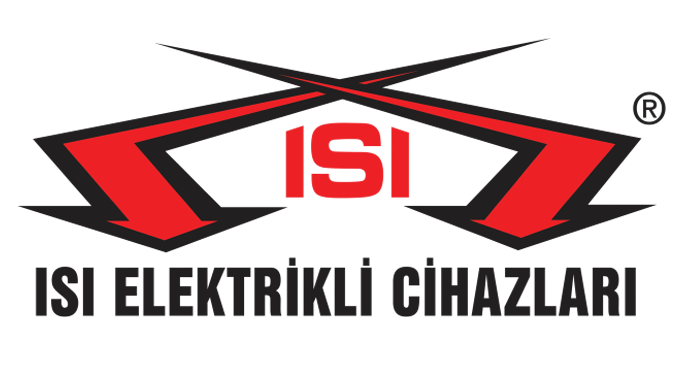
-500x500w.jpg)
-500x500w.jpg)
-500x500w.jpg)
-500x500w.jpg)
